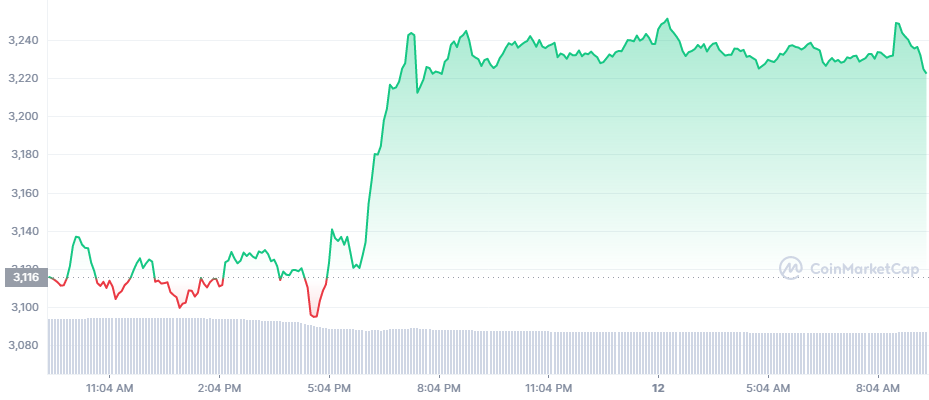Ethereum (ETH) Recovers Ahead of Bitcoin (BTC)

Ethereum (ETH) is having a more robust recovery in the past day, outpacing Bitcoin (BTC). ETH returned above $3,200, gaining around 3.7% on the day. The BTC recovery saw the leading coin return to the $41,800 range, with less than 2% net gains.
ETH traded around $3,237.05 early on Wednesday, as the market continued with signs of abandoning its bottom levels.
ETH has received predictions of a highly active year, with events diminishing the supply and a network update to proof of stake.
ETH is also raising hopes for other networks, as more blockchain-enabled apps appear. Binance Coin (BNB) also showed a more significant recovery above $480 as the asset attempts to recover previous levels. The crypto market is still valued under $2T, with BTC relling just under $42,000 as of January 11.
What Brings ETH Scarcity
The Ethereum network has worked on a different fee schedule since August 2021. Instead of going to miners, ETH fees for each transaction are partially burned. The fees are also a combination of miner income and burning coins.
The latest upgrade for ETH means the network will consume between $1B and $2B in notional value just to run for one year, and this at current ETH valuations.
The net result is that at the moment, ETH creation via mining and ETH burns through fees are generating a net negative. This means the Ethereum network remains deflationary, while the Bitcoin network still has a small but steady level of inflation.
Even at an hourly scale, ETH is chipping away at the total supply of tokens.
The Ethereum network intended to cap the supply at 84M tokens, but mining continues at close to 120M tokens. Constant fee burns are curbing the growth, in addition to tokens locked for staking.
Since the launch of the new fee schedule, more than 1.45M ETH have been burned. The base fee gets destroyed, and only on rare occasions there is a high priority fee requirement to boost transaction speed.
ETH transaction fees are engineered to make the base fee relatively predictable, with a goal of optimizing for 50% block filling. Higher or lower activity adjusts the base fee up or down.
ETH Keeps Adding New Addresses
Despite the competition from other networks, the Ethereum blockchain keeps adding unique addresses. Growth comes from DeFi adoption and new game launches. ETH is still needed to move both fungible tokens and NFT items.
A similar rate of increase is noted on the Ethereum mining chart, reaching 947 EH/s, a 300% growth over the past year. For now, the new fee schedule has not made miners give up on the network, and in fact they increased their activity as actual ETH was more scarce.
DeFi Keeps Making Fast Recoveries
DeFi value locked is once again above $91B despite a temporary dip. The most recent price shakedowns have affected TVL for Ethereum-based projects, but there are also signs of fast recoveries, based on successful algorithmic protection preventing some of the worse liquidations.
During the latest price crash, ETH liquidations reached $22.9M based on Coinglass statistics.
Despite ETH volatility, for now the DAI dollar-pegged coin has managed to keep its $1 valuation with little volatility.
ETH 2.0 Contract Keeps Attracting Coins
The ETH 2.0 contract, which locks a minimum of 3.2 ETH, has already collected more than 9M tokens.
Along with token burns and DeFi collaterals, this source of limiting ETH available is making a dent on ETH available. A significant sum of coins should also go to future transactions and fees, as Ethereum is here to stay. Fees are needed even for moving to alternative networks and sidechains, and back to the Ethereum main network.
Is ETH 2.0 Really Developing
One of the doubts for 2022 is the relatively slow development of Ethereum’s network. The move to ETH 2.0 was promised years ago. Instead, Ethereum evolved through a series of annual or twice-yearly upgrades.
According to recent explanations from Vitalik Buterin, Ethereum’s co-founder, the actual completion of proof of stake and shift to ETH 2.0 may take years.
At the same time, new types of networks keep gaining both influence with developers and value locked. If Ethereum takes too long, it may lose its appeal for building. For now, the biggest advantage of the network are the numerous projects and the widely accepted standard of ERC-20 tokens.
What is less widely known is that ETH transactions are far less decentralized than expected. Most transactions go through browser extension wallets and use services like Infura to validate the balance. The Ethereum network record is simply too large and is kept on a limited number of services. Years of network history means amateur miners or wallet owners can no longer download the entire network and verify the distributed ledger.

Uphold makes buying crypto with popular currencies like USD, EUR and GBP very simple with its convenient options to swap between crypto, fiat, equities, and precious metals.

With over 50 coins and an obsession with security, Kraken is one of the safest places to buy and trade crypto.

Kraken has a good reputation for security and protection of your funds and operates across the USA (except NY), Canada, the EU and Japan

Based in Charleston, South Carolina. Serves over 184 countries and has done over $4 billion in transactions. Offers convenient options to swap between crypto, fiat, equities, and precious metals.

The basics of cryptocurrency portfolios and how to get started in tracking your crypto holdings

In Part 1 of the guide we look at the stochastic oscillator, relative strength index and moving averages

The leader in programmable money, smart contracts and decentralised applications. There have been many copycats but none have the community and level of adoption.

An early alternative to Bitcoin, LTC aimed to be a coin for easy, fast, low-fee spending. LTC offers a faster block time and a higher transaction capacity in comparison to Bitcoin.